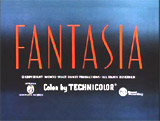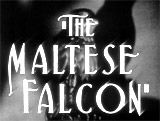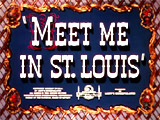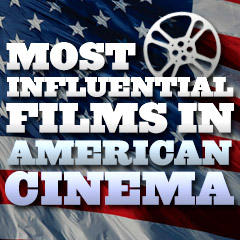Most Influential, Significant
and Important Films in American Cinema
(chronological by time period and film title)
|
|
Title Screen
|
Film Title/Year/Director/Length/Studio,
Descriptions of Influence/Significance |
Poster
|

|
Fantasia (1940)
d. Various directors, 124 minutes, Walt Disney Pictures
- Disney's ground-breaking
animated feature-length "concert" film
milestone, with great works of Western classical music, was an
outgrowth of the "Silly Symphony" series.
- An ambitious
experiment to try to popularize classical music, especially by
accompanying it with animation. It integrated eight magnificent
classical musical compositions interpreted with enchanting, exhilarating,
and imaginative, artistically-choreographed animation.
- The film, with a production cost of more than $2
million (about four times more than an average live-action picture),
initially failed at the box-office, partially due to the expensive
installation of "Fantasound" sound
reproduction equipment in theatres. The "Fantasound" 'stereo-like',
multi-channel soundtrack was an optical 'surround-sound' soundtrack
printed on a separate 35mm reel from the actual video portion of the
film. It
was the first American film to use stereophonic sound as well as the
first and only film recorded in Fantasound.
- The film received a special certificate at the 1941
Academy Awards for its revolutionary Fantasound (early stereo).
- Originally, the film was to consist of only the
classic Mickey Mouse segment: "The Sorcerer's Apprentice."
- The only Walt Disney animated feature film that
was two-hours long, at 124 minutes.
- Often imitated or duplicated - e.g., Disney's own
'unofficial' sequel Make Mine Music (1946), Bruno Bozzetto's Allegro
non troppo (1976), parts of The Land Before Time (1988).
|

|

|
Citizen Kane (1941)
d. Orson Welles, 119 minutes, RKO Radio Pictures/Mercury
Productions
- A fresh, sophisticated, and classic masterpiece,
and probably the world's most famous and highly-rated film, with
its many remarkable scenes and performances, cinematic and narrative
techniques and experimental innovations (in photography, editing,
and sound). Often considered the "greatest film
ever made" on
most 'best of' lists.
- A prime example of the director-centric auteur
theory before
it was clearly defined decades later - it showcased the achievements
of a maverick director-cowriter-producer-star in one film, 25 year-old
independent wunderkind Orson Welles, who was the controlling
author of the film (not the studio, screenwriter, producers,
or others) - it was his debut feature film over which he was
given total freedom by RKO. With his four Academy Awards nominations
(Best Picture-producer, Best Actor, Best Director, and Best Original
Screenplay), Welles became the first individual
to receive simultaneous nominations in those four important categories.
- The innovative, bold film is an acknowledged milestone
in the development of cinematic technique, with
many advances in cinematic movie-making. It brought together and consolidated
everything in 'film-language' up until that time, and then broke some
new ground with deep focus photography, unconventional lighting,
including chiaroscuro, lengthy takes, low-angled shots revealing
ceilings in sets, sophisticated directional sound editing, overlapping
dialogue, the sound technique termed "lightning-mix," elaborate
camera movements, and flashbacks, flashforwards and non-linear
narrative story-tellin (shot
from various viewpoints).
- The film began with just a title screen - no performer
names - an unprecedented thing in the early 1940s, although common
place today.
- Welles was a trailblazer for future film-makers
who wanted to expand the boundaries of film, such as Francis Ford
Coppola, Martin Scorsese, and Quentin Tarantino.
- A great example of how external forces can ruin
(or help) a film's chances - i.e., publishing tycoon William Randolph
Hearst accused the film of wrongly portraying him as a ruthless,
publishing tycoon who died alone in the castle.
|

|

|
The Maltese Falcon (1941)
d. John Huston, 100 minutes, Warner Bros.
- One of the most popular, stylistic and best classic
detective mysteries ever made - a mixture of
mystery, romance, and thriller.
- Many film historians consider
it the first major dark film
noir production
in Hollywood - although it had antecedents. Some of the other most
influential noirs of the time period included Double Indemnity
(1944) and The Blue Dahlia (1946) (with Alan Ladd).
- The low-budget film reflected the remarkable directorial
debut of John Huston (previously a screenwriter) who efficiently
and skillfully composed and filmed this American classic for Warner
Bros. studios, with great dialogue, deceitful characters, a great
femme fatale, and menacing scenes.
- B-movie lead character Humphrey Bogart, now introduced
as a 'good guy', presented the definitive anti-hero Sam Spade - a cynical,
cool San Francisco sleuthing private-eye who lived by his own code
of ethics.
- There were only two of the
lead-based, bejeweled Maltese Falcon statuettes
originally created by the Props Department for the film. Each lead
figurine was 45-pounds and 12 inches tall. The only
known film-used Falcon sold at auction for almost $4.5 million
in late 2013 - making it one of the rarest and most important movie
props or memorabilia ever offered for public sale.
- The black bird served as
the film's McGuffin,
a plot device that propelled the story forward but was proven ultimately
worthless - although it wasn't termed that at the time. Detective
Spade famously called the worthless fake statuette: "the stuff
that dreams are made of" (cribbed from Shakespeare's
The Tempest).
- When originally considered for release, the censorial
Hays Code office was concerned about the amount of drinking, cursing,
and sexual innuendos in the risque film, especially the amoral
and promiscuous Mary Astor character. Also, they considered the
homosexual references unacceptable (Peter Lorre's effeminate homosexuality,
and young homosexual "gunsel" Elisha
Cook, Jr.), and they had to be toned down.
|

|

|
Meet Me in St. Louis (1944)
d. Vincente Minnelli, 113 minutes, MGM
- A delightful, classic, nostalgic, poignant, and
romanticized musical film - and one of the greatest musicals ever
made - a gem of cinematic, picture-postcard Americana and youthful
romance. A favorite Christmas-time holiday film classic.
- The Technicolor film marked the beginning of
the golden age of MGM musicals (and legendary producer Arthur Freed's
unit), and ultimately became the second most successful film for
MGM (behind Gone
With the Wind (1939)).
- The film abandoned the 'put-on-a-show' mentality
of so many other backstage song/dance films, or the Busby Berkeley-style
of show-stopping production numbers. Its songs and wonderful performances
were carefully and naturally integrated into the story of the close-knit
family's day-to-day life, and served to thematically advance the
action and plot from one season to the next.
- The film was composed of a series of coming-of-age vignettes
(four in number): different acts representing the seasons
from summer 1903 to spring 1904 that conclude in the year of
the St. Louis World's Fair/Exposition. Each segment marked changes
and rites of passage - and was introduced by a filigreed tintype
from the Smith family album - each static, initially sepia-toned
image turned into color and came to life.
- This film marked the first significant film role,
and probably her career-best effort, for beautiful actress Judy
Garland since The Wizard of Oz (1939).
|

|








